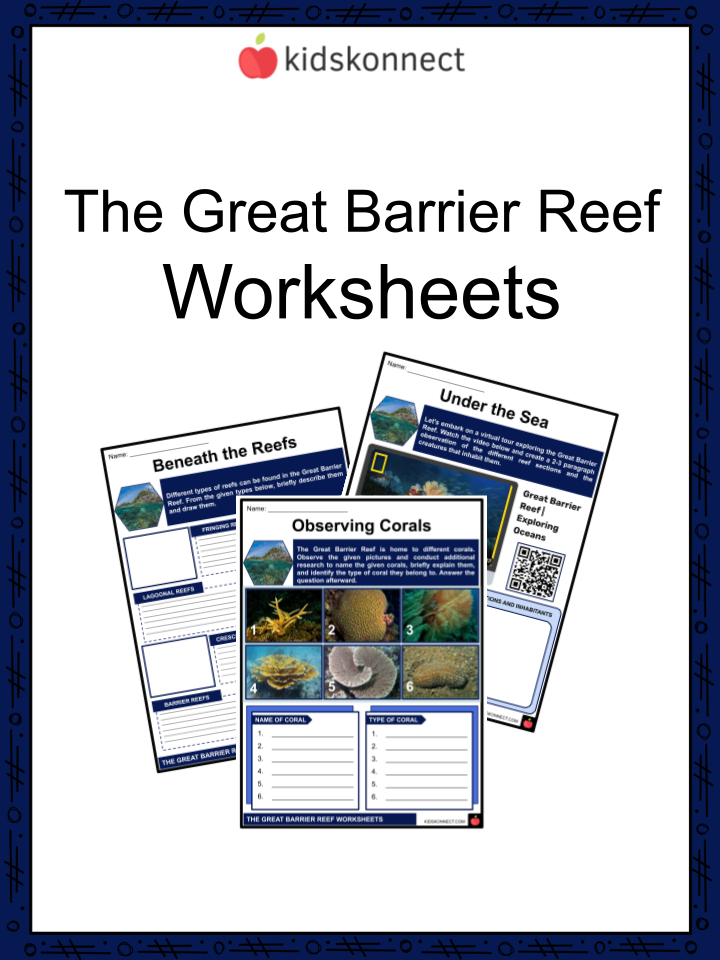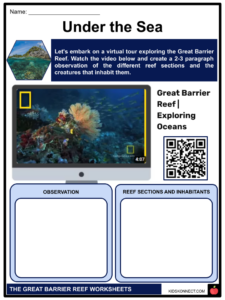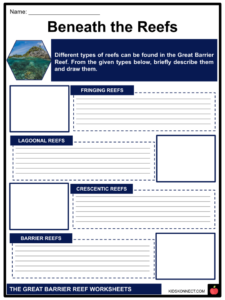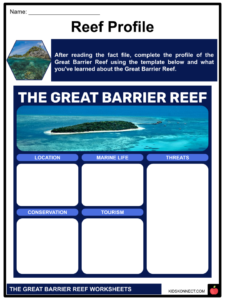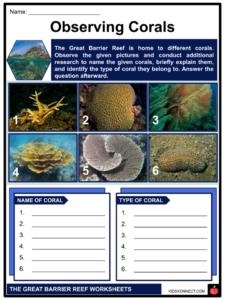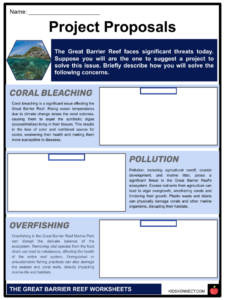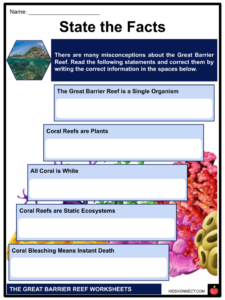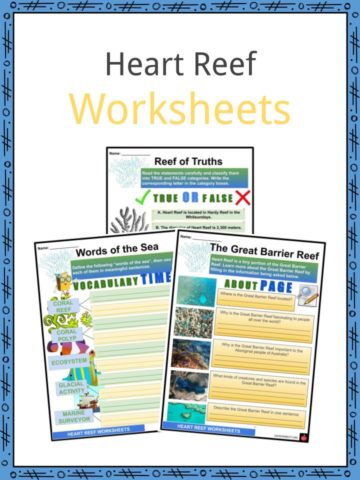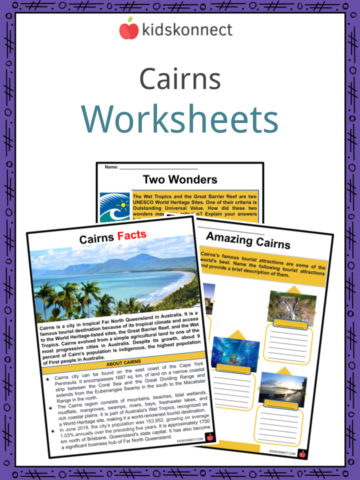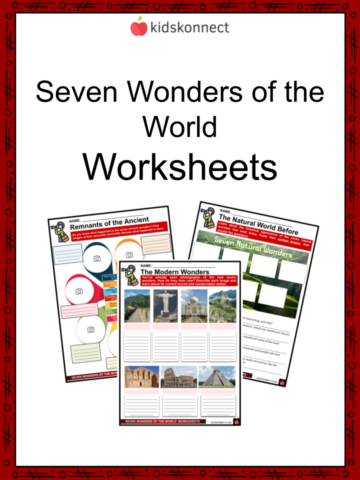Download This Sample
This sample is exclusively for KidsKonnect members!
To download this worksheet, click the button below to signup for free (it only takes a minute) and you'll be brought right back to this page to start the download!
Sign Me Up
Table of Contents
The Great Barrier Reef is the largest coral reef system in the world. It is located off the coast of Queensland in Australia. The Great Barrier Reef covers a total area of 34,870,000 hectares and includes nearly 3,000 individual reefs and 900 islands.
See the fact file below for more information on The Great Barrier Reef, or you can download our 30-page Great Barrier Reef worksheet pack to utilize within the classroom or home environment.
Key Facts & Information
WHAT IS THE GREAT BARRIER REEF?
- The Great Barrier Reef is the world’s most extensive coral reef system.
- A coral reef forms when large groups of coral polyps grow together in a colony.
- Coral polyps are tiny marine animals related to the sea anemone and jellyfish that live in oceans worldwide.
- A barrier reef is a coral reef running parallel to the shore but separated by a large lagoon, hence the word barrier.
- The Great Barrier Reef is the world’s most extensive single-structure living organisms.
- The Great Barrier Reef comprises over 900 islands and over 2,900 individual reefs.
- The Great Barrier Reef stretches for over 1,400 mi (2,300 km) over approximately 133,000 sq mi (344,400 sq km).
Type of Reef
- Fringing Reefs
- It grows directly from the shoreline and has a shallow or non-existent backreef zone.
- Lagoonal Reefs
- Held together by coral and are sometimes called the “rainforests of the sea.”
- Crescentic Reefs
- Crescent-shaped reefs with an open-back reef area.
- Planar Reefs
- Flat reefs; are found in the Northern and Southern parts of the reef.
- Fringing Reefs
WHERE IS THE GREAT BARRIER REEF?
- The Great Barrier Reef is located off the east coast of Australia.
- It is in the Coral Sea and is separated from the coast of Queensland, Australia, by a channel about 100 miles wide up to 200 feet deep.
WHEN AND HOW WAS THE GREAT BARRIER REEF FORMED?
- Around 24 million years ago, the tropical conditions around Queensland became ideal for coral to grow.
- The Great Barrier Reef formed as a result of coral reef growth in the Coral Sea Basin.
- The Great Barrier Reef Marine Park Authority estimates that the oldest and most complete reef structures were present around 600,000 years ago.
- As the sea levels have risen over time, so have the coral reefs. Some small islands also became submerged, providing optimal spaces for coral to grow.
THE GREAT BARRIER REEF ECOLOGY
- The Great Barrier Reef supports various plant and marine animal life.
- Several species of endangered plants and animals rely on the nutrients and protection of The Great Barrier Reef to survive.
- Saltwater crocodiles live in areas surrounding the reef, as well as 30 species of dolphins and porpoises.
- More than 1,500 fish species live in and among the reef.
- The Great Barrier Reef is also home to 17 species of sea snakes.
- Six species of sea turtles come to this reef to breed. These are the green sea turtle, the leatherback sea turtle, the hawksbill turtle, the loggerhead sea turtle, and the flatback turtle.
- The Olive Ridley sea turtle also calls The Great Barrier Reef home. This turtle is unique because it is one of the smallest sea turtles. It has a heart-shaped shell that is olive green in color.
- Other species found in and around the reef include:
- 215 species of birds
- 330 species of ascidians
- 125 species of sharks and stingrays
- 49 species of pipefish
- 9 species of seahorses
- 7 species of frogs
- nearly 5,000 species of mollusk
- On the northern and southern regions of the reef, 1.4-1.7 million birds go to breed each year.
- The islands of The Great Barrier Reef are home to more than two thousand species of plants.
- The northern islands tend to have more woody plants, while the south has more herbaceous plants.
ENVIRONMENTAL IMPACT AND CLIMATE CHANGE
- Some of the threats facing The Great Barrier Reef include:
- Climate change because, as global warming continues, corals cannot keep up with increasing ocean temperatures.
- Fishing because this impacts the reef through increased water pollution from boats and fishermen.
- Accidental oil spills into the water, which causes extensive damage to the reef.
- Shipping because accidents have left over 1,600 known shipwrecks in the Great Barrier Reef region.
- Farming because fertilizer runoff creates disturbances in the water chemistry, and too many algae grow.
- Ocean warming causes coral bleaching when coral expels the algae that live inside them. This is caused when the water temperature becomes too warm.
- Algae provides the coral with 90% of its nutrients, so when it is expelled, it begins to starve and will usually begin to die.
- Between 2014 and 2016, the most extended global bleaching occurred, which removed 29-50% of The Great Barrier Reef’s coral.
- Many events can trigger bleaching, including:
- Oxygen starvation
- Increased sunlight
- Bacterial infections
- Changes to the salinity of the water
- During tropical events, such as a cyclone, the rivers, and bodies of water around the reef flood and pollute the reef.
- Farming fertilizer runoff can also seep into the water and pollute the reef by releasing harmful chemicals.
CONSERVATION
- Marine Protected Areas: The Great Barrier Reef Marine Park Authority has established multiple marine protected areas within the reef system to restrict certain activities and protect sensitive habitats.
- Coral Restoration: Conservationists and researchers are working to restore damaged coral reefs by cultivating coral fragments in nurseries and transplanting them back onto the reef.
- Climate Action: Efforts are made to address climate change, the main threat to the reef. Advocacy for reducing greenhouse gas emissions is crucial to mitigate warming waters and coral bleaching.
- Water Quality Management: Reducing pollution and sediment runoff from agriculture and development is vital to maintain water quality and prevent damage to coral health.
- Sustainable Fishing: Implementing responsible fishing practices, such as size and bag limits, helps protect fish populations and maintain the balance of the ecosystem.
- Tourism Guidelines: Sustainable tourism practices are promoted, including responsible snorkeling and diving, to minimize physical damage to coral and marine life.
- Research and Monitoring: Extensive research and monitoring programs track the health of the reef, assess the impacts of climate change, and inform management decisions.
- Educational Outreach: Educational initiatives aim to raise awareness about the reef’s importance and the actions individuals can take to support conservation.
- International Collaboration: Collaborative efforts involving governments, researchers, NGOs, and international organizations are working towards a coordinated approach to reef protection.
- Community Engagement: Local communities are actively involved in conservation projects, such as reef cleanups and restoration activities, fostering a sense of ownership and responsibility.
- Policy and Legislation: Strong policies and regulations are in place to manage and protect the reef’s ecosystems and biodiversity.
- Innovation and Technology: Innovative solutions, such as underwater drones for monitoring and data collection, contribute to better understanding and management of the reef.
- Funding and Grants: Governments and organizations provide funding and grants to support research, conservation projects, and sustainable initiatives.
FUN FACTS
- The Great Barrier Reef is so massive it can be seen from outer space.
- The Great Barrier Reef was selected as a World Heritage Site in 1981.
- CNN labeled The Great Barrier Reef as one of the world’s seven natural wonders in 1997.
- Australian World Heritage places included The Great Barrier Reef in its list in 2007.
- The Queensland National Trust named The Great Barrier Reef a state icon of Queensland in 2006.
Great Barrier Reef Worksheets
This fantastic bundle includes everything you need to know about The Great Barrier Reef across 30 in-depth pages. These ready-to-use worksheets are perfect for teaching kids about The Great Barrier Reef. The Great Barrier Reef covers a total area of 34,870,000 hectares and includes nearly 3,000 individual reefs and 900 islands.
Complete List of Included Worksheets
Below is a list of all the worksheets included in this document.
The Great Barrier Reef is made of over three thousand reefs of coral. There are many creatures living in The Great Barrier Reef, including dolphins, sharks, turtles, snakes, and even worms. Yes, coral is alive. Corals are formed by tiny creatures called polyps that grow in colonies to form coral reefs. Coral reefs are made up of thousands of coral polyps which feed off of algae which gives the corals their colors. Corals are more often shades of brown but can also be beautiful shades of green, red or blue. Coral can become white when stressed. There are a multitude of different kinds of coral on The Great Barrier Reef. There is a variety of both hard corals and soft corals in a variety of colors. If you reference any of the content on this page on your own website, please use the code below to cite this page as the original source. Link will appear as Great Barrier Reef Facts & Worksheets: https://kidskonnect.com - KidsKonnect, February 8, 2018 Use With Any Curriculum These worksheets have been specifically designed for use with any international curriculum. You can use these worksheets as-is, or edit them using Google Slides to make them more specific to your own student ability levels and curriculum standards.
Frequently Asked Questions
What is The Great Barrier Reef made of?
What creatures live in The Great Barrier Reef?
Is coral alive?
What color are coral reefs?
Are there different types of coral in The Great Barrier Reef?
Link/cite this page
